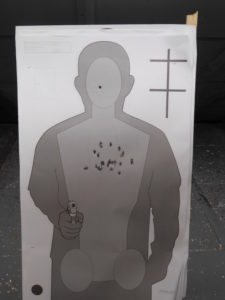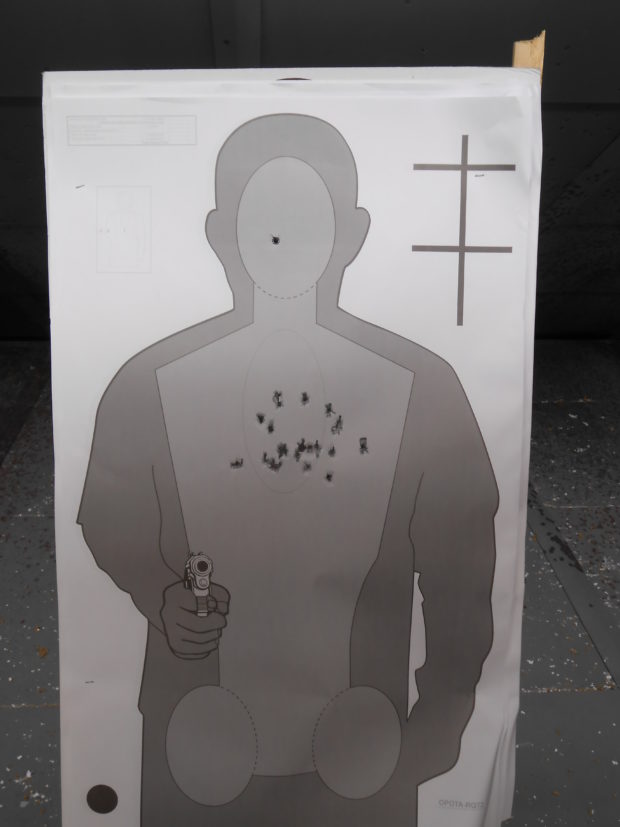Written by: Greg Ellifritz
My friend Claude Werner recently wrote an article where he postulated most shooters don’t do any real structured practice with their firearms. They plink or play, but they generally don’t perform drills designed with realistic standards in order to improve performance. In the article, Claude talked about sharing details and photos of his practice routines to give novice shooters an idea about how they might better spend their practice time.
I think that is a wonderful idea. I plan on sharing the drills I shoot in my weekly practice sessions. Hopefully, you will get a little value out of my posts or come up with some new drills to make your own practice sessions more effective.
This post will be a little different from my previous ones. My most recent practice session was in-service training conducted by the firearms instructors at my police department. At my department, we currently get one full day of training every three months. Last week, the morning training was a re-certification on CPR/AED and a re-familiarization with tourniquets and pressure bandages to stop traumatic bleeding. The afternoon consisted of shooting drills. Here’s what we did:
We started out with a “standard” drill that our instructors use in every training session to measure performance. The two targets are 1/2 of a standard size sheet of copier paper. Range is 30 feet. Draw and fire two shots to each of the two targets as fast as possible. Repeat for a total of three times. My times were slightly over the four second mark. Some of the officers in the group had times that were twice as long with several misses as well.
We continued practicing by firing from the various ready positions (low, high, and compressed). Single shots by command at a silhouette target at 30 feet.
Drawing practice. Draw and fire a single shot at a USPSA A-Zone target from 30 feet. Reholster and repeat approximately 20 times concentrated on making the draw smooth and getting on the sights as early in the drawstroke as possible. No time limits.
Drawing from seated position and safe movement with the gun in hand. At 30 feet shooting a silhouette target. Fire one shot from the seated position (stools placed on range). Move to a position of cover and fire one more shot. Repeat five times.
We then did a drill using three separate targets. Each target was partially obscured by a “hostage.” Each target had a different sized “open” place of engagement. Draw and fire one shot to each of the three targets without hitting the “hostage.” Repeat drill with two shots on each target and then three shots on each target. My time on the three shot version (9 total shots from the holster) was 4.79 seconds. That was the fastest of the day. Most of my co-workers were in the 8-10 second range.
“Wrong tool” drill. Starting out with alternate object (baton, taser, handcuffs) in the shooting hand, on command, drop the object, draw and fire two shots. Repeat 6 times.
Shooting on B-8 bullseye targets for score:
- 5 shots, 5 seconds, 15 feet
- 5 shots, 10 seconds, 30 feet
- 5 shots, 15 seconds, 45 feet
Precision shooting drill, one magazine shot slow fire at very tiny (sub 1″) targets at 10 feet.
More precision shooting. Target is a 2″ circle. No time limit. Three shots each at 9, 15, 21, 30, 45 feet. I ended up with three total rounds outside the circles.
A “divided attention” shooting drill at 21 feet where each students had to fire a set number of rounds on multiple targets after doing some basic math in their head. It’s a fun drill, but tough to describe on paper. Officers who couldn’t mentally add and subtract quickly were screwed on this one.
I ended up shooting 192 rounds in about three hours. For those of you who aren’t cops, this amount of shooting is what most cops get for training on an annual basis. Some departments don’t even do this much.
The drills our instructors chose were just fine. They accomplished the goal of giving the officer practice in shooting under the constraints that officers normally face on the street. I have no complaints with this session, but I don’t think firing a 200 round session a couple times a year is enough firearms practice for a police officer. I shoot about this amount of rounds every single week on my own.



